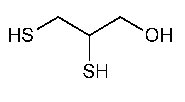Dimercaprol
»Dimercaprol contains not less than 97.0percent and not more than 100.5percent of C3H8OS2,and not more than 1.5percent of 1,2,3-trimercaptopropane (C3H8S3).
Packaging and storage—
Preserve in tight containers,in a cold place.
Specific gravity á841ñ:
between 1.242and 1.244.
Refractive index á831ñ:
between 1.567and 1.573.
Limit of 1,2,3-trimercaptopropane and related impurities—
Adsorbent—
Use a suitable chromatographic grade of 100-mesh silicic acid.
Standard buffer solution—
Prepare 100mLof pH6.0Phosphate Buffer (see pHá791ñ),and dissolve in it 100mg of sodium bisulfite.
Acid-washed solvent hexane—
To 100mLof solvent hexane contained in a separator add 10mLof sulfuric acid,shake for not less than 12hours,and allow the layers to separate.Transfer the acid-washed solvent to a distilling flask,and distill slowly,retaining only that portion distilling between 35 and 50
and 50 .Use only freshly distilled material.
.Use only freshly distilled material.
Diisopropyl ether—
Place 100mLof diisopropyl ether in a distilling flask,and distil,retaining only that portion distilling between 68 and 69
and 69 .Use only freshly distilled material.[Caution—Do not evaporate to the point of near-dryness,since diisopropyl ether tends to form explosive peroxides
]
.Use only freshly distilled material.[Caution—Do not evaporate to the point of near-dryness,since diisopropyl ether tends to form explosive peroxides
]
Solvent hexane-diisopropyl ether mixture
(mobile solvent)—Mix 50mLof Diisopropyl etherwith 50mLof Acid-washed solvent hexane.
Chromatographic tube—
Insert a small plug of glass wool at the juncture of the tube and the stem of a 600-×13-mm chromatographic tube.
Chromatographic column—
Mix 20g of Adsorbentwith 20mLof Standard buffer solution.Make into a slurry by mixing with 100mLof chloroform.Transfer successive portions of the slurry into the Chromatographic tube,packing firmly and evenly with a close-fitting,ground-glass tamper after each addition.Keep a layer of liquid above the packed column to prevent the formation of air spaces.Wash the column free from chloroform with Solvent hexane-diisopropyl ether mixture,and allow the solvent to fall to the level of the Adsorbent.
Procedure—
Place about 250mg of Dimercaprol,accurately weighed and demonstrated to be free from hydrogen sulfide as directed in the Assay,in a 5-mLvolumetric flask,add Solvent hexane-diisopropyl ether mixtureto volume,and mix.Transfer 2.0mLof the resulting solution to the prepared Chromatographic column.When the liquid has passed into the column,wash the wall of the tube with a 2-mLportion of Solvent hexane-diisopropyl ether mixture,and allow the washing to fall to the level of the Adsorbent.Fill the Chromatographic tubewith solvent,and collect two successive fractions:(A)a 20-mLfraction containing all of the 1,2,3-trimercaptopropane,and (B)a 3-mLfraction that serves as a check on the separation.To each fraction add an equal volume of alcohol,and titrate with 0.1Niodine VSuntil a permanent yellow color is produced.Perform a blank titration on 20mLof the solvent mixture that has been passed through the column prior to introduction of the test specimen,and make any necessary correction.Fraction (B)does not decolorize 1drop of 0.1Niodine VS.Each mLof 0.1Niodine added is equivalent to 4.676mg of C3H8S3.Not more than 1.5%of 1,2,3-trimercaptopropane (C3H8S3)is found.
Assay—
Test the Dimercaprol for the presence of hydrogen sulfide by examining the vapor above the assay specimen with moistened lead acetate test paper.If the paper darkens,bubble dry,oxygen-free nitrogen or carbon dioxide through the assay specimen until a fresh strip of test paper gives a negative test.Transfer about 2mLof hydrogen sulfide-free Dimercaprol to a tared,glass-stoppered,100-mLvolumetric flask,weigh accurately,add methanol to volume,and mix.Pipet 10mLof the solution into a 50-mLconical flask,and titrate with 0.1Niodine VSuntil a permanent yellow color is produced.Perform a blank titration,and make any necessary correction.Calculate the percentage of C3H8OS2taken by the formula:
0.6211V/W-1.328T,
in which Vis the volume,in mL,of 0.1Niodine used,Wis the weight,in g,of specimen in the aliquot taken,and Tis the percentage of C3H8S3found in the determination of the Limit of 1,2,3-trimercaptopropane and related impurities.
Auxiliary Information—
Staff Liaison:Elena Gonikberg,Ph.D.,Scientist
Expert Committee:(PA4)Pharmaceutical Analysis 4
USP28–NF23Page 661
Pharmacopeial Forum:Volume No.29(5)Page 1466
Phone Number:1-301-816-8251
